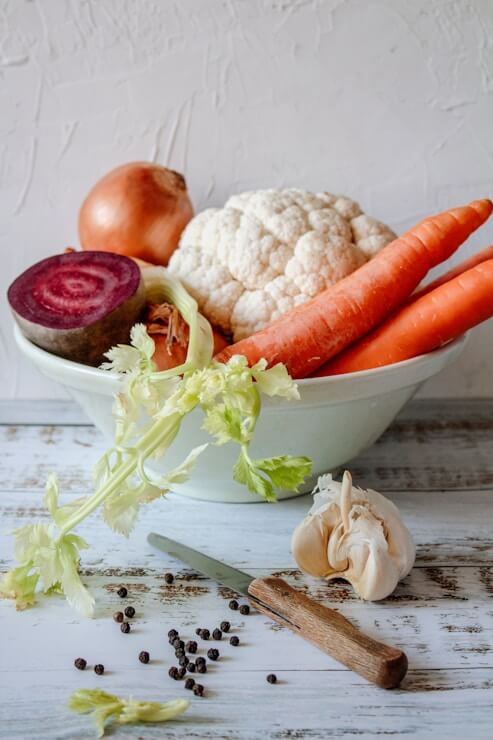Inflammation is a natural process that helps your body fight off infections and heal injuries. However, chronic inflammation can contribute to many health problems, including arthritis, heart disease, and even some cancers.
The good news? Your diet plays a powerful role in managing inflammation, especially when it’s packed with nutrient-rich, plant-based ingredients.
Embracing anti-inflammatory vegan recipes is not only great for your health but also delicious and satisfying.
In this post, we’ll explore a vibrant, flavorful recipe that harnesses the power of whole foods like turmeric, ginger, leafy greens, and berries, all known for their anti-inflammatory properties. Whether you’re a seasoned vegan or simply looking to add more plant-based meals to your routine, this recipe is easy to prepare and perfect for any occasion.
Let’s dive into a nourishing dish that supports your well-being and delights your taste buds!
Why You’ll Love This Recipe
This recipe is a celebration of fresh, whole ingredients that naturally reduce inflammation while providing essential vitamins, minerals, and antioxidants. It’s 100% plant-based, making it suitable for vegans and anyone seeking a healthier lifestyle.
The combination of spices like turmeric and ginger adds a warm, earthy flavor profile, enhancing not only taste but also health benefits.
Additionally, this dish is highly adaptable. Whether you’re looking for a quick weeknight meal, meal prep for the week ahead, or a colorful addition to your dinner table, it fits seamlessly.
Plus, it’s gluten-free, oil-free, and packed with fiber to support digestion and overall gut health.
For more wholesome vegan inspiration, be sure to check out our Almond Cashew Clusters Recipe and the comforting flavors of All American Chili Recipe Cooking Light. These pair beautifully with anti-inflammatory meals and keep your menu exciting!
Ingredients
| Ingredient | Quantity |
|---|---|
| Quinoa (rinsed) | 1 cup |
| Water | 2 cups |
| Fresh spinach (chopped) | 3 cups |
| Red bell pepper (diced) | 1 medium |
| Carrot (grated) | 1 large |
| Turmeric powder | 1 teaspoon |
| Fresh ginger (grated) | 1 tablespoon |
| Garlic cloves (minced) | 3 cloves |
| Chickpeas (cooked or canned, rinsed) | 1 can (15 oz) |
| Extra firm tofu (pressed and cubed) | 200 grams |
| Olive oil | 2 tablespoons |
| Lemon juice | 2 tablespoons |
| Ground cumin | 1 teaspoon |
| Black pepper | ½ teaspoon |
| Sea salt | to taste |
| Fresh parsley (chopped) | ¼ cup |
| Chia seeds (optional, for topping) | 1 tablespoon |
Equipment
- Medium saucepan with lid
- Large skillet or frying pan
- Cutting board
- Sharp knife
- Grater (for ginger and carrot)
- Mixing bowls
- Wooden spoon or spatula
- Measuring cups and spoons
Instructions
- Cook the quinoa: In a medium saucepan, combine the rinsed quinoa and water. Bring to a boil, then reduce heat to low, cover, and simmer for 15 minutes or until the water is absorbed. Remove from heat and let it rest covered for 5 minutes, then fluff with a fork.
- Prepare the tofu: While the quinoa cooks, heat 1 tablespoon of olive oil in a large skillet over medium heat. Add the cubed tofu and sauté until golden brown on all sides, about 6-8 minutes. Remove tofu from the skillet and set aside.
- Sauté the aromatics: In the same skillet, add the remaining olive oil. Stir in the minced garlic, grated ginger, and turmeric powder. Cook for 1-2 minutes until fragrant, stirring constantly to prevent burning.
- Add vegetables and spices: Toss in the diced red bell pepper, grated carrot, and chopped spinach. Sprinkle with ground cumin, black pepper, and sea salt. Cook for 5-7 minutes until the vegetables soften and the spinach wilts.
- Combine chickpeas and tofu: Add the drained chickpeas and cooked tofu back into the skillet. Stir well to combine all ingredients and heat through for another 3 minutes.
- Finish with lemon and herbs: Remove the skillet from heat. Drizzle the lemon juice over the mixture and gently fold in the chopped parsley for a fresh burst of flavor.
- Serve: Place a generous scoop of quinoa on each plate and top with the sautéed vegetable-tofu mixture. Sprinkle chia seeds on top for an extra nutritional boost, if desired.
Tips & Variations
For an extra anti-inflammatory punch, add a pinch of black pepper to your turmeric dishes. It enhances curcumin absorption dramatically!
You can swap quinoa for brown rice or millet if you prefer. To add more texture, consider tossing in some toasted walnuts or pumpkin seeds.
If you like your meal spicier, a dash of cayenne pepper or crushed red chili flakes works beautifully.
For a creamy dressing, blend soaked cashews with lemon juice, garlic, and a bit of water to drizzle over your dish. This adds richness without compromising the anti-inflammatory benefits.
Looking for other wholesome recipes? Try our AIP Vegetarian Recipes for autoimmune-friendly options or the vibrant Arlington Chicken Salad Recipe made vegan for a delightful twist.
Nutrition Facts
| Nutrient | Amount per Serving |
|---|---|
| Calories | 350 kcal |
| Protein | 18 g |
| Carbohydrates | 45 g |
| Dietary Fiber | 10 g |
| Fat | 10 g |
| Vitamin A | 120% DV |
| Vitamin C | 85% DV |
| Iron | 25% DV |
| Calcium | 15% DV |
Serving Suggestions
This anti-inflammatory vegan dish pairs wonderfully with a light side salad dressed in lemon vinaigrette or a bowl of homemade vegetable soup. For a heartier meal, serve alongside warm whole-grain bread or gluten-free flatbread.
Consider complementing the flavors with a refreshing turmeric-ginger tea or a vibrant berry smoothie to enhance the anti-inflammatory benefits. Looking for a delicious dessert to follow?
Try the Almond Cake And Pastry Filling Recipes for a sweet yet wholesome finish.
Conclusion
Incorporating anti-inflammatory vegan recipes into your diet is a fantastic way to support your overall health and well-being. This recipe combines the best of nature’s ingredients—rich in antioxidants, vitamins, and minerals—to help reduce inflammation and promote vitality.
Beyond the health benefits, it’s a delicious, colorful, and satisfying meal that’s easy to prepare any day of the week.
By choosing plant-based, nutrient-dense ingredients like turmeric, ginger, leafy greens, and legumes, you’re not only nourishing your body but also delighting your palate. Remember, cooking is an opportunity to experiment and enjoy the process, so feel free to adapt this recipe to your tastes and pantry.
For more inspiration on wholesome vegan dishes, don’t miss our collection of recipes like the Cheese Pasta Cheesecake Factory Recipe and the flavorful Bak Chor Mee Recipe: Authentic Singaporean Noodle Guide.
Happy cooking and here’s to your health!
📖 Recipe Card: Anti Inflammatory Quinoa & Chickpea Salad
Description: A vibrant, nutrient-packed salad rich in anti-inflammatory ingredients like turmeric and leafy greens. Perfect for a light, wholesome vegan meal.
Prep Time: PT15M
Cook Time: PT20M
Total Time: PT35M
Servings: 4 servings
Ingredients
- 1 cup quinoa, rinsed
- 1 1/2 cups water
- 1 can (15 oz) chickpeas, drained and rinsed
- 2 cups baby spinach, chopped
- 1/2 cup diced cucumber
- 1/2 cup shredded carrots
- 1/4 cup chopped fresh parsley
- 1/4 cup chopped walnuts
- 2 tbsp olive oil
- 1 tbsp lemon juice
- 1 tsp ground turmeric
- 1/2 tsp ground black pepper
- Salt to taste
Instructions
- Cook quinoa in water until fluffy, about 15 minutes.
- In a large bowl, combine cooked quinoa and chickpeas.
- Add spinach, cucumber, carrots, parsley, and walnuts.
- In a small bowl, whisk olive oil, lemon juice, turmeric, black pepper, and salt.
- Pour dressing over salad and toss to combine.
- Serve immediately or chill for 30 minutes for enhanced flavor.
Nutrition: Calories: 350 kcal | Protein: 12 g | Fat: 14 g | Carbs: 45 g

